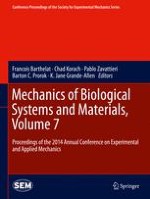2015 | Buch
Mechanics of Biological Systems and Materials, Volume 7
Proceedings of the 2014 Annual Conference on Experimental and Applied Mechanics
herausgegeben von: Francois Barthelat, Chad Korach, Pablo Zavattieri, Barton C. Prorok, K. Jane Grande-Allen
Verlag: Springer International Publishing
Buchreihe : Conference Proceedings of the Society for Experimental Mechanics Series
